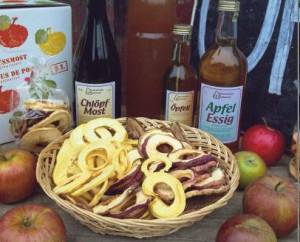La tradizione dell’aceto di mele
Description
As with vine, one can obtain vinegar from apple most. The procedure is the same: One has to only leave the most in contact with Fresh air and after about a month at a constant temperature of 28 Degrees one gets vinegar. First the apples Need to be washed, then fragmented as small as possible and pressed. The liquid is left with the air in a warm room. Even better it is to leave the squashed apples to ferment for about a month and only then press them. The liquid is fed into a basked bottle; one Needs to take care that the liquid Level does not exceed the point where the bottle is widest. Alcohol turns into vinegar only in the presence of air. It is important that this transformation Begins immediately so that the "cidre" does not disappear (which can happen if the air contact area is too small) otherwise the Quality of the vinegar is endangered. Apples without pesticides are much easier to use because treated apples hamper fermentation. In These cases one often has to fall back to fermenting substances to start the process.
If the strength of the vinegar is supposed to increase one can add rotten apples, they speed up the process without the bad taste remaining.
One of the best apple vinegars is obtained by mixing these species: Rosa Montovana (for the smell), Rosso Nobile (for the sweetness) and Bella di Boskoop (for the body).
After about one year (between fermentation, vinegar conversion and improvement) one gets a Wonderful product. The natural vinegar is slightly foggy, like Fresh Juice. The commercial vinegar is clear, without Deposition, which is a sign of pasteurization and filtration, or for gelatine-forced fermentation which removes vitality, and thus reduces the organoleptic and Health Advantages of the product.








